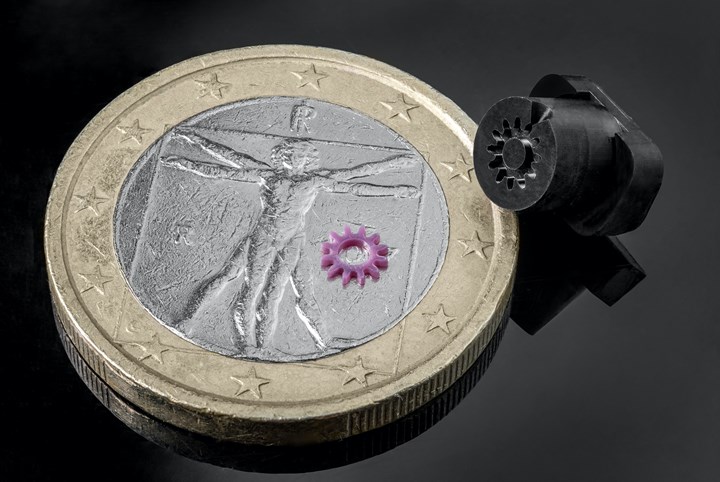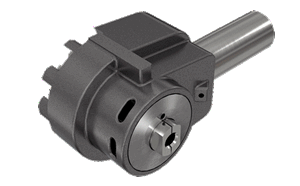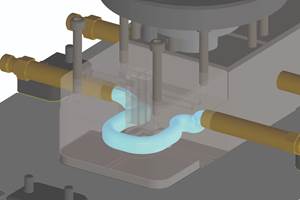Direct Rapid Soft Molds Open Up New Applications in Micro Injection Molding
Nanofabrica's Direct Rapid Soft Tooling (DRST) process enables lead times of two hours from file to injected part. With up to 1000 injection-molded parts per tool, the technology unlocks potential applications in small or medium-batch manufacturing.
Fast and economic prototyping and pilot production is essential for industrial manufacturers in the precision engineering sector. One possibility is Direct Rapid Soft Tooling (DRST), the direct manufacturing of inserts for injection molds by additive manufacturing technologies. However, injection molding parameters such as cycle time or injection pressures are significantly different to conventional injection molding production. Heat deflection, wear, and accuracy are among the key challenges, because many available print materials usually allow either high accuracy or high temperature resistance.
When it comes to the production of micro components with shot weights that frequently amount to only a few milligrams, even more stringent requirements apply to injection molding, including low shear stresses, the provision of thermally and mechanically homogeneous material and a reproducible plasticizing procedure.
Israel-based micro additive manufacturing (AM) technology developer, Nanofabrica, has been working on developing materials and AM processes suitable for printing soft molds for micro injection applications, and has now accomplished a breakthrough which enabled the printing of a mold that lasted 20 shots, with plans to increase this to 1000 shots in the coming months, the company says.

In initial experiments, the molds lasted for 20 shots with a molding pressure of 400 bar at 230°C.
“The time and cost associated with the fabrication of conventional tooling for injection molding means that many OEMs are assessing the viability of creating AM produced DRST for short run production parts and functional prototypes,” Jon Donner, CEO at Nanofabrica says. “As a company, Nanofabrica is consistently experimenting week-to-week in the area of AM mold tool fabrication as it recognizes the huge potential benefits for manufacturers, and is consistently achieving improvements in mechanical capabilities, mold designs, materials, and the accuracy and integrity of parts injected using AM molds.”
According to Donner, the demand for AM-produced DRST has been held back by perceptions that AM is limited in terms of surface finish, precision, accuracy, repeatability and a limited number of materials to be processed.
High Resolution for Precise Micro Features
Nanofabrica’s AM process is said to achieve ultra-precise 1 micron resolution enabling a high surface finish (Rz = 0.8 micron, Rz = 0.1 micron in Z-plane). “For prototyping or first tool trials, time-consuming and costly conventional machining of molds can be eliminated. Uniquely, the high resolution that Nanofabrica’s technology achieves means that it can create extremely precise and micro features, and this is a key attribute that manufacturers are also keen to take advantage of,” Donner says.
In its recent experiments, Nanofabrica succeeded in injecting PP, PE, and ABS into a 3D printed mold, which was manufactured on the company’s Terra 250 AM platform (build volume: 50 mm x 50 mm x 100 mm), with a new material Nanofabrica is currently developing. The machine is based on DLP Stereolithography (SLA), works with a resolution of 1.9 micron, a layer thickness of 2 microns and a build speed of 1 mm/hour. Materials supported are ABS-like Polypropylene-like, flexible Polypropylene-like, Alumina based and Zirconia.
In the initial experiments, the molds lasted for 20 shots with a molding pressure of 400 bar at 230°C. It took Nanofabrica an hour to additively manufacture one mold at the cost of under $20. The materials were injected using an Arburg 35-ton machine.
According to the company, the trials were initiated at the request of key industry players who were interested in assessing the time and cost savings that are inherent when producing DRST as opposed to conventional hard steel tools for injection molding. In addition, the companies were eager to achieve the high surface finish as well as tiny features and complexity possible through the use of Nanofabrica’s AM technology which are effectively impossible using conventional machining of molds.
Our aim is to achieve 1000 shots in the coming months.
“We are fine tuning the manufacture of our DRST through a combination of design optimization and improvements in materials,” Tovit Neizer, VP Business Development at Nanofabrica adds. “While we are getting a good 20 shots off this preliminary testing, we are working on improving both the material as well as the process with the aim of handling tougher injection conditions and a bigger array of injected materials. We have a final goal of reaching injection parameters of T = 350 °C and pressures of 800 bar.”
“We are aiming at improving both thermal and mechanical properties. More specifically, improving the HDT (heat deflection temperature) as well as thermal conductivity. On the mechanical side we are focusing on improving the impact pressure and stiffness of the printed part. Our aim is to achieve 1000 shots in the coming months. This unlocks new business possibilities for mold makers and manufacturers who up until this point have been restricted to the use of long lead time and expensive traditionally manufactured mold tools for the achievement of any volume of molding, from prototype runs all the way through to mass production. The Nanofabrica trials should stimulate the business case for a process chain that includes DRST, with a dramatically shorter lead time of about two hours from file to injected part and at costs reduced from thousands of dollars to tens.”
Suitable for Small and Medium Batch Production
Using Nanofabrica’s Terra 250 precision AM platform to produce DRST capable of manufacturing upwards of 1000 parts per tool opens up the possibility of small and even medium batch manufacturing. This is a product of Nanofabrica’s platform that is able to accommodate the manufacture of multiple small tools in each build, and so manufacturers will be able to produce numerous replacement tools at extremely low cost, Neizer explains.
“The rest is just math! In the future, for the cost of one aluminum precise mold which costs about $10K you could manufacture 500 soft molds on a Terra 250, leading to about 500K final parts through a significantly faster process. In addition, each tool can be adapted as required, opening up the possibility of speed to first part out, and the ability to correct during the manufacturing process according to market and customer needs.”
While the savings in terms of product development time and cost are seen as the most compelling benefits for using AM-produced DRST instead of traditional injection molds, it could also stimulate innovation in product design and manufacture, Neizer says. “AM can achieve geometries impossible using conventional processes, and as such is positioned as a key enabling technology driving the production of cutting-edge products as well as shortening the product development cycle. This is because it is quite often the case that product design updates are shelved by manufacturers due to the cost of new traditional molds.”
Related Content
A 3D Printing Retrospective
A personal review of the evolution of 3D printing in moldmaking throughout the past 25 years.
Read More3D Printing Enables Better Coolant Delivery in Milling Operations
Just like 3D printing enabled conformal cooling channels in molds, additive manufacturing is now being used to optimize coolant delivery in cutting tools.
Read MoreHow to Supply Cooling to Additive Tooling
Additive tooling provides limitless options for cooling a mold’s difficult-to-cool areas.
Read MorePrecision Meets Innovation at IMTS 2024
After attending IMTS, it's clear that the integration of advanced technologies is ready to enhance precision, efficiency and automation in mold manufacturing processes. It’s a massive event, so here’s a glimpse of what the MMT team experienced firsthand.
Read MoreRead Next
How to Use Strategic Planning Tools, Data to Manage the Human Side of Business
Q&A with Marion Wells, MMT EAB member and founder of Human Asset Management.
Read MoreHow to Use Continuing Education to Remain Competitive in Moldmaking
Continued training helps moldmakers make tooling decisions and properly use the latest cutting tool to efficiently machine high-quality molds.
Read MoreAre You a Moldmaker Considering 3D Printing? Consider the 3D Printing Workshop at NPE2024
Presentations will cover 3D printing for mold tooling, material innovation, product development, bridge production and full-scale, high-volume additive manufacturing.
Read More






















